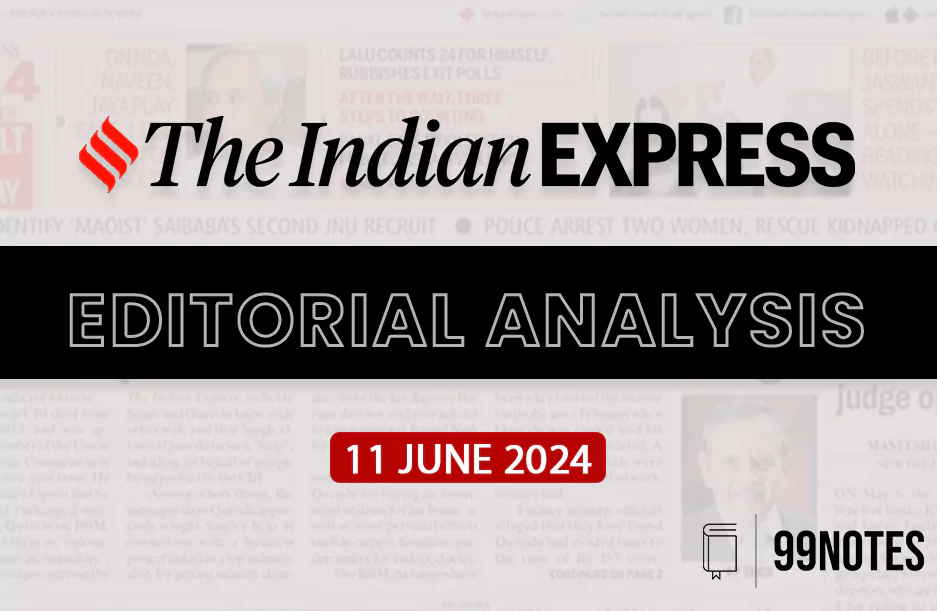11 June 2024 : Indian Express Editorial Analysis
1. A new federal bargain
| Topic: GS2 – Polity |
| Context: |
|
Modi’s First Term: Cooperative Federalism Initiatives:
- During Modi’s first term (Modi 1.0), the government made significant changes in Centre-state relations.
- The Planning Commission was abolished and replaced by Niti Aayog, aimed at strengthening cooperative federalism.
- Another landmark reform was the implementation of the Goods and Services Tax (GST), the most significant fiscal federalism reform since India’s Constitution was promulgated.
Modi’s Second Term: Centralization Moves:
- In Modi 2.0, the government’s actions signaled a shift towards greater centralization.
- The abrogation of Article 370 emphasized this trend, highlighting the use of a strong parliamentary majority to advance a one-nation policy.
- The proposal for “One nation, one election” further demonstrated this centralizing agenda.
Emerging Tensions: North-South Divide:
- As the election approaches, tensions over federalism have surfaced, particularly regarding the pending delimitation exercise. This has stirred concerns of a north-south divide, with less populous, opposition-dominated southern states fearing a reallocation of parliamentary representation favoring more populous, BJP-dominated northern states.
- This threatens to destabilize India’s fiscal federal pact, which redistributes taxes from richer southern and western states to poorer northern states..
Coalition Politics: A Potential Federal Reset:
- The return to coalition government, with regional parties as key power-brokers and the BJP’s increased electoral stake in the south, presents an opportunity to restore trust and balance in federalism.
- Governing in coalition may introduce multiple centers of power, counteracting the centralization of decision-making in the Prime Minister’s Office.
- However, regional parties are not inherently strong advocates for federalism.
Regional Parties’ Influence on Federalism:
- Regional parties in a national coalition typically prioritize their own interests, such as negotiating for cabinet positions or special status for their states.
- While they raise national issues like the caste census, their vision for Centre-state relations remains unclear.
- Special-interest regional politics could jeopardize a wider federal bargain if it appears to be driven by partisanship rather than principles, potentially extending the concept of a “double engine” government beyond the BJP to the NDA coalition.
Divergence from BJP’s Vision:
- It is uncertain how far coalition partners will diverge from the BJP’s “one nation” vision for federalism.
- For instance, following the abrogation of Article 370, some regional parties expressed support for the unified national framework.
- There is no inherent reason to expect that the presence of regional parties will enhance advocacy for all states’ interests vis-à-vis the Centre.
A Vision for Renewed Federalism
- This period of political change could be a time for reflection on a renewed federalism that balances the interests of the Centre and the states.
- Strengthening the institutional space for dialogue and decision-making between the Centre and all states, not just those governed by the NDA, should be a priority.
Empowering the Inter-State Council
- A practical step would be to empower the Inter-State Council, established following the Sarkaria Commission on Centre-state relations in the late 1980s.
- Currently within the Ministry of Home Affairs, it lacks the independence and authority needed to be a trusted body by both the Centre and the states.
- Granting it greater independence and statutory responsibilities could enhance Centre-state and inter-state dialogue.
Building Trust and Consensus
- To build trust over the delimitation exercise, a process for genuine consensus building among all states should be announced.
- A federal solution respecting principles of representation and redistribution, without undermining states’ voices and autonomy, is in the interest of all parties.
- Precedents like the harmonization of indirect taxes leading to the GST demonstrate the value of inter-state dialogue and consensus.
Conclusion:
- Harnessing this moment to offer a new vision for federalism, where the Centre and states build trust and collaborate, would benefit all parties as India looks to the future.
- Strengthening cooperative mechanisms and empowering institutions like the Inter-State Council are essential steps towards this goal.
| What has been the Role of Coalition Governments in Reforms? |
|
Historical Context:
Notable Reforms by Previous Coalition Governments: P V Narasimha Rao Government (1991-1996):
Deve Gowda Government (June 1996-April 1997):
Atal Bihari Vajpayee Government (March 1998-May 2004):
Manmohan Singh Government (2004-2014): Rights-Based Reforms:
|
| PYQ: How far do you think cooperation, competition and confrontation have shaped the nature of federation in India? Cite some recent examples to validate your answer. (150 words/10m) (UPSC CSE (M) GS-2 2020) |
| Practice Question: Discuss the implications of the return of coalition politics in India on federalism and Centre-state relations. What steps can be taken to strengthen cooperative federalism and build trust between the Centre and the states? (250 words/15 m) |
(Source: Indian Express; Section: The Editorial Page; Page: 10)
2. FROM MARGIN TO CENTRE
| Topic: GS2 – Social Justice – Vulnerable Sections |
| Context: |
|
Charismatic Authority and Popularity:
- The Weberian concept of “charismatic authority” aptly describes PM Modi’s leadership. Under his tenure, the BJP has promoted the idea of one nation, strengthening nationalism and instilling a deep sense of patriotism among citizens.
- Modi’s image is central to the admiration he receives from various demographics, including Dalits. The 2024 election, often termed “Modi ka election,” saw his popularity eclipse even the BJP’s iconic lotus symbol, especially in rural areas.
- His emphasis on stability, development, and progress, known as the “Modi guarantee,” has garnered widespread trust.
Honoring Ambedkar’s Legacy:
- PM Modi has honored Dr. B.R. Ambedkar’s legacy through initiatives like the Ambedkar Panchteerth.
- This respect for Ambedkar’s contributions has resonated with Dalit communities, significantly increasing their support for the BJP from 24% in 2014 to 36% in 2019.
- Under Modi, social harmony and unity have been prioritized, contributing to this shift.
Infrastructure and Economic Growth:
- Modi fought the election on his record of infrastructure development, investment, innovation, and inclusivity. Initiatives like Make in India have propelled the country towards atma nirbharta (self-reliance), positioning India as a global manufacturing hub.
- This industrial boom has particularly benefited women and youth, including a significant proportion of Dalits, uplifting many into a new middle class.
- Despite educational reservations, many backward communities, Dalits, Adivasis, and minorities still lack university degrees, limiting their service industry opportunities.
- However, the manufacturing sector’s growth has created employment opportunities for these marginalized groups.
Modi vs. Nehru: A New Era:
- PM Modi’s leadership is often compared to that of India’s first Prime Minister, Jawaharlal Nehru. However, this is a different era—one of an assertive, aspirational India.
- Re-electing Modi during a time of relative peace and economic growth contrasts with past eras of war and instability.
- History will likely remember Modi for his action-oriented politics, transforming vote-bank politics into GYAN pillars. Voters, both urban and rural, now prioritize real issues over rhetoric and fear-mongering.
Women’s Empowerment in Elections:
- The 2024 elections saw a significant increase in female voter turnout, with 64.95% of women casting their votes.
- This rise can be attributed to awareness of government schemes and increased knowledge of how to access them.
- Women’s issues have overshadowed caste and communal concerns in this election, highlighting a shift in voter priorities.
Global Engagement and Domestic Impact:
- India’s active engagement in global politics has also influenced its internal political landscape.
- The 2024 verdict reinforces India’s aspiration to become a “vishwaguru” (world teacher).
- Voters are increasingly aware of India’s global standing, influenced by events like the G20 summit and India’s lunar mission.
- India’s evolving global stature has become a significant factor in domestic elections.
Conclusion:
- The 2024 elections allowed voters to express their aspirations and define their expectations from the government.
- As we enter a new era of consensus politics, the government’s role will be to ensure that the ideals, interests, and inclusion of the marginalized are prioritized.
- This move towards inclusive governance is both welcome and long-awaited.
| Practice Question: Discuss the impact of Narendra Modi’s leadership on India’s development and inclusive governance over the past decade. How has his leadership style influenced voter behavior and the political landscape, particularly in the 2024 elections? (250 words/15 m) |
(Source: Indian Express; Section: The Editorial Page; Page: 10)





